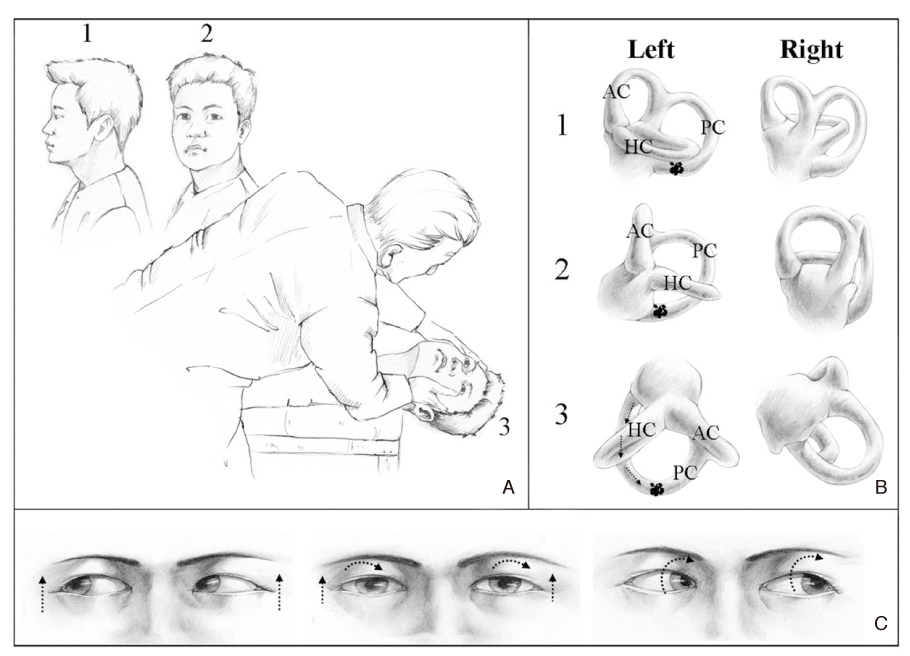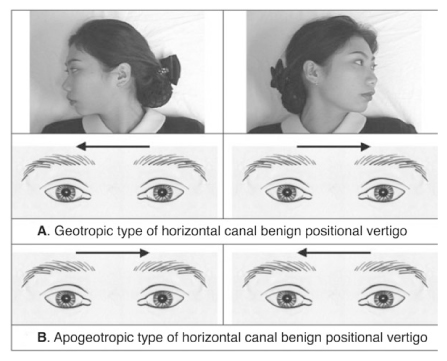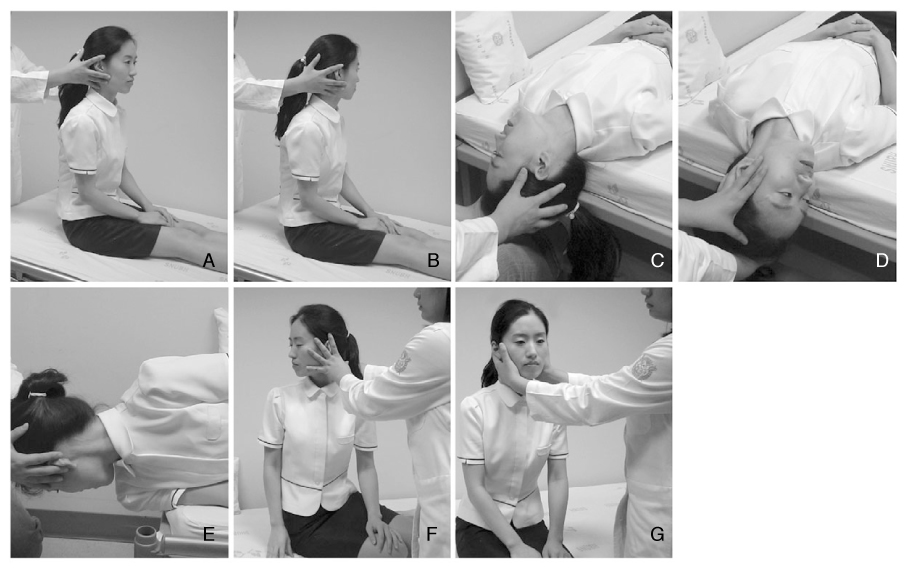J Korean Med Assoc.
2008 Nov;51(11):984-991. 10.5124/jkma.2008.51.11.984.
Benign Paroxysmal Positional Vertigo
- Affiliations
-
- 1Department of Neurology, Chonnam National University College of Medicine, Korea. nrshlee@chonnam.ac.kr
- 2Department of Neurology, Seoul National University College of Medicine, Korea. jisookim@snu.ac.kr
- KMID: 2137741
- DOI: http://doi.org/10.5124/jkma.2008.51.11.984
Abstract
- Benign paroxysmal positional vertigo (BPPV) is characterized by brief recurrent episodes of vertigo triggered by head position changes. BPPV is one of the most common causes of recurrent vertigo. BPPV results from abnormal stimulation of the cupula within any of the three semicircular canals by free-floating otoliths (canalithiasis) or otoliths adhered to the cupula (cupulolithiasis). Typical symptoms and signs of BPPV are evoked when the head is positioned so that the plane of the affected semicircular canal is spatially vertical and thus aligned with gravity. Paroxysm of vertigo and nystagmus develops after a brief latency during Dix-Hallpike maneuver in posterior canal BPPV and supine roll test in horizontal canal BPPV. Usually positioning the head in the opposite direction reverses the direction of the nystagmus. The duration, frequency, and intensity of symptoms of BPPV vary depending on the involved canals and the nature of otolithic debris. Spontaneous recovery occurs frequently even with conservative treatment, however, canalith repositioning maneuvers are believed to be the best way to treat BPPV by moving the canaliths from the semicircular canal to the vestibule.
Figure
Cited by 1 articles
-
Clinical approach to patients with dizziness
Jae Han Park, Youngrok Do, Ji Soo Kim
J Korean Med Assoc. 2018;61(1):44-48. doi: 10.5124/jkma.2018.61.1.44.
Reference
-
1. von Brevern M, Radtke A, Lezius F, Feldmann M, Ziese T, Lempert T, Neuhauser H. Epidemiology of benign paroxysmal positional vertigo: a population based study. J Neurol Neurosurg Psychiatry. 2007. 78:710–715.
Article2. Steenerson RL, Cronin GW, Marbach PM. Effectiveness of treatment techniques in 923 cases of benign paroxysmal positional vertigo. Laryngoscope. 2005. 115:226–231.
Article3. Moon SY, Kim JS, Kim BK, Kim JI, Lee H, Son SI, Kim KS, Rhee JK, Han KC, Lee WS. Clinical characteristics of benign paroxysmal positional vertigo in Korea: a multicenter study. J Korean Med Sci. 2006. 21:539–543.
Article4. Fife TD, Iverson DJ, Lempert T, Furman JM, Baloh RW, Tusa RJ, Hain TC, Herdman S, Morrow MJ, Gronseth GS. Practice Parameter: Therapies for benign paroxysmal positional vertigo (an evidence-based review): Report of the Quality Standards Subcommittee of the American Academy of Neurology. Neurology. 2008. 70:2067–2074.
Article5. Baloh RW, Honrubia V, Jacobson K. Benign positional vertigo: clinical and oculographic features in 240 cases. Neurology. 1987. 37:371–378.
Article6. Lempert T, Leopold M, von Brevern M, Neuhauser H. Migraine and benign positional vertigo. Ann Otol Rhinol Laryngol. 2000. 109:1176.
Article7. Cohen HS, Kimball KT, Stewart MG. Benign paroxysmal positional vertigo and comorbid conditions. ORL J Otorhinolaryngol Relat Spec. 2004. 66:11–15.
Article8. Vibert D, Kompis M, Haüsler R. Benign paroxysmal positional vertigo in older women may be related to osteoporosis and osteopenia. Ann Otol Rhinol Lanyngol. 2003. 112:885–889.
Article9. Ziavra NV, Bronstein AM. Is uric acid implicated in benign paroxysmal positional vertigo? J Neurol. 2004. 251:115.
Article10. Barany R. Diagnose von Krankheitserscheinunen im berieche des oolithenapparates. Acta Otolaryngol. 1921. 2:434–437.11. Dix R, Hallpike CS. The pathology, symptomatology, and diagnosis of certain common disorders of vestibular system. Proc R Soc Med. 1952. 54:341–354.12. Schuknecht HF. Cupulolithiasis. Arch Otolaryngol. 1969. 90:765–778.
Article13. Hall SF, Ruby RRF, McClure JA. The mechanics of benign paroxysmal vertigo. J Otolaryngol. 1979. 8:151–158.14. Parnes LS, McClure JA. Free-floating endolymph particles: a new operative finding during posterior semicircular canal occlusion. Laryngoscope. 1992. 102:988–992.15. McClure JA. Horizontal canal benign positional vertigo. J Otolaryngol. 1985. 14:30–35.16. Baloh RW, Yue Q, Jacobson KM, Honrubia V. Persistent direction-changing positional nystagmus: Another variant of benign positional nystagmus? Neurology. 1995. 45:1297–1301.
Article17. Bisdorff AR, Debatisse D. Localizing signs in positional vertigo due to lateral canal cupulolithiasis. Neurology. 2001. 57:1985–1988.
Article18. Han BI, Oh HJ, Kim JS. Nystagmus while recumbent in horizontal canal benign paroxysmal positional vertigo. Neurology. 2006. 66:706–710.
Article19. Koo JW, Moon IJ, Shim WS, Moon SY, Kim JS. Value of lying-down nystagmus in the lateralization of horizontal semicircular canal benign paroxysmal positional vertigo. Otol Neurotol. 2006. 27:367–371.
Article20. Lee SH, Choi KD, Jeong SH, Oh YM, Koo JW, Kim JS. Nystagmus during neck flexion in the pitch plane in benign paroxysmal positional vertigo involving the horizontal canal. J Neurol Sci. 2007. 256:75–80.
Article21. Kim JS. Positional downbeating nystagmus: Tips from the transitions. J Korean Balance Soc. 2002. 2:235–239.22. Imai T, Ito M, Takeda N, Uno A, Matsunaga T, Sekine K, Kubo T. Natural course of the remission of vertigo in patients with benign paroxysmal positional vertigo. Neurology. 2005. 64:920–921.
Article23. Brandt T, Daroff RB. Physical therapy for benign paroxysmal positional vertigo. Arch Otolaryngol. 1980. 106:484–485.
Article24. Semont A, Freyss G, Vitte E. Curing the BPPV with a liberatory maneuver. Adv Otorhinolaryngol. 1988. 42:290–293.
Article25. Epley JM. The canalith repositioning procedure: for treatment of benign paroxysmal positional vertigo. Otolaryngol Head Neck Surg. 1992. 107:399–404.
Article26. Macias JD, Ellensohn A, Massingale S, Gerkin R. Vibration with the canalith repositioning maneuver: A prospective randomized study to determine efficacy. Laryngoscope. 2004. 114:1011–1014.
Article27. Gordon CG, Gadoth N. Repeated versus single physical maneuver in benign paroxysmal positional vertigo. Acta Neurol Scand. 2004. 110:166–169.
Article28. Hilton M, Pinder D. The Epley (canalith repositioning) manoeuvre for benign paroxysmal positional vertigo. Cochrane Database Syst Rev. 2004. 2:CD003162.
Article29. Lempert J. Horizontal benign positional vertigo. Neurology. 1994. 44:2213–2214.
Article30. Vannucchi P, Giannoni B, Pagnini P. Treatment of horizontal semicircular canal benign paroxysmal positional vertigo. J Vestib Res. 1997. 7:1–6.
Article31. Appiani GC, Catania G, Gagliardi M, Cuiuli G. Repositoning maneuver for the treantment of the apogeotropic variant of horizontal canal benign paroxysmal positional vertigo. Otol Neurotol. 2005. 26:257–260.
Article32. Gufoni M, Mastrosimone L, Di Nasso F. Repositioning maneuver in benign paroxysmal vertigo of horizontal semicircular canal. Acta Otorhinolaryngol Ital. 1998. 18:363–367.33. Honrubia V, Baloh RW, Harris MR, Jacobson KM. Paroxysmal positional vertigo syndrome. Am J Otol. 1999. 20:465–470.34. Leveque M, Labrousse M, Seidermann L, Chays A. Surgical therapy in intractable benign paroxysmal positional vertigo. Otolaryngol Head Neck Surg. 2007. 136:693–698.
Article
- Full Text Links
- Actions
-
Cited
- CITED
-
- Close
- Share
- Similar articles
-
- Positional Dizziness and Vertigo without Nystagmus and Orthostatic Hypotension
- Diagnosis of Benign Paroxysmal Positional Vertigo
- Model Experiment of Benign Paroxysmal Positional Vertigo
- Vestibular Paroxysmia Mimicking Benign Parxysmal Positional Vertigo
- The History of Research in Vestibular Organ and Benign Paroxysmal Positional Vertigo




